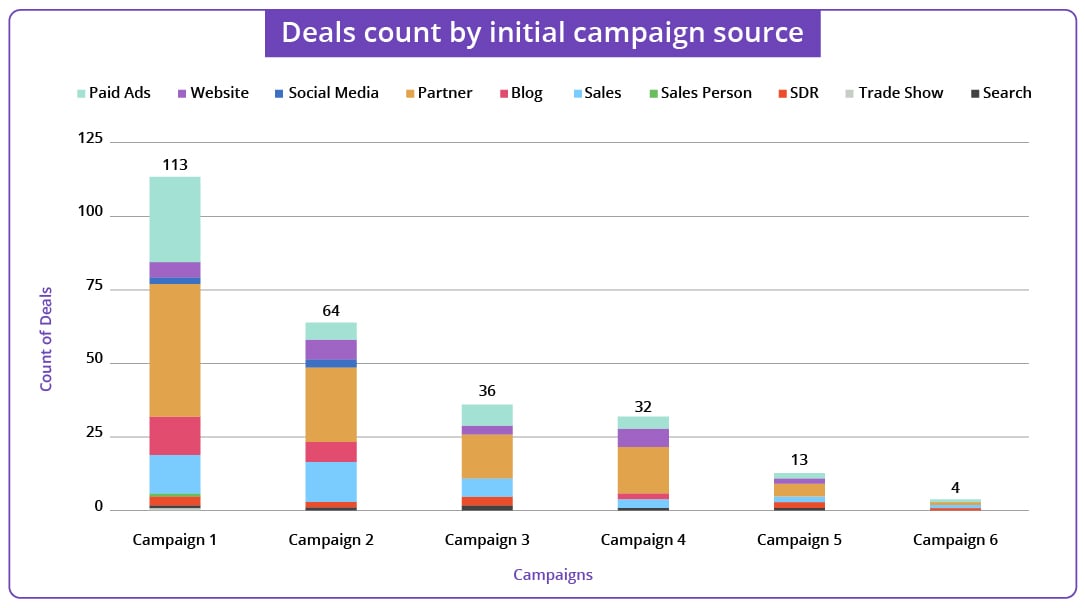![5 Key B2B Marketing KPIs CMOs Must Track in 2021 [+EXAMPLES]](https://www.penguinstrategies.com/hubfs/Blog%2029%20B2B%20CMO%20KPIs%20to%20track/KPIs%20tracked%20by%20a%20B2B%20CMOs%20BLOG.jpg)
It is easy for a new CMO or marketing manager to become inundated with daily tasks, meetings, and generating those first wins. And then there are all the KPIs to track (because what gets measured, gets improved). But which KPIs should you focus on now, especially when there are so many? I’ll share what I’ve learned after working with many CMOs.
Where your company is will help you prioritize which KPIs to track. For example, at pre-Round A, a B2B startup typically needs to bring in a few deals—regardless of how much effort and money it takes. As the company evolves from needing to prove the product-market fit, the focus switches to establishing a customer acquisition funnel where the cost of an opportunity has a positive ROI. This changes the game.
In this blog, we’ll focus our example on a company that is moving into a growth stage where they need to scale up sales and look at the most important KPIs at each stage of the customer journey.
5 Key B2B Marketing KPIs for CMOs To Track
1. Traffic - Monthly Sessions
What is a “session?” It’s one visitor’s page-to-page journey on your website. Sessions usually correlate with overall brand exposure and can contribute to many important goals.
Increased monthly sessions should contribute to increasing leads, brand awareness, authority and ranking. So despite the comment I often get from B2B CMOs that website sessions is sometimes just a “vanity metric,” it’s actually a super-important one that needs to be tracked.
TIP: If you notice that an increased number of sessions is not resulting in an increased number of conversions (i.e. subscriptions to your newsletter, blog or forms filled), rethink how you are bringing this traffic to your website.
Use Google Analytics to determine how many monthly sessions are new visitors vs. how many are returning visitors.
Most of our B2B clients want to:
- Increase their monthly new leads (via new traffic) and
- Nurture their existing audience.
If you share this second goal, make sure there’s also significant traffic from your existing audience. New content such as helpful blogs, educational resources, product updates and news, for example, will keep your funnel-dwellers coming back.
Also, optimize the most-visited pages on your website for the personas in your audience who are visiting those pages.
2. Leads - MQLs vs Contacts
This is the KPI tracked by every CMO I know. Everybody wants leads, right? (Especially the CEO.)
But as a B2B CMO, we need to make sure that we are bringing in the right leads. This is why we distinguish between “Leads” and “MQLs.”
What’s the difference?
These are the common definitions used among our clients:
Lead: Someone who downloaded one or more gated items and gave their consent to receive emails (i.e. they subscribed to the newsletter.)
MQL (Marketing Qualified Lead): Someone who fits the firmographics of the target persona. For a lot of companies, this is someone whose title or role matches a targeted persona and the person is from a targeted company.
TIP: As the company matures, we can set more specific qualifications for MQLs, for example: rules that are based on scoring.
Qualifying a Lead as an MQL
There are various ways to determine if a Lead should be an MQL. In the beginning, when we don’t have a lot of leads, the qualification is often done manually by Googling the leads’ names or companies and deciding if they match our criteria.
TIP: As we build out our digital marketing and improve it, we should automate the qualification process.
Automating the qualification process is important because we can trigger specific follow-up actions as soon as somebody becomes an MQL. This improves conversions dramatically. Learn how to automate qualifying leads as MQLs.
Lead Scoring
Another way to qualify leads or identify an MQL or an SQL is by scoring people by the actions they take on our website.
For example, we can set up our marketing automation to raise the score of a person according to how much time they spent on our product pages in the past week and/or which content they downloaded. Each action is accorded a number of points. Passing a predetermined threshold will trigger a specific email flow around the product offerings or content they showed interest in.
TIP: Track how many people progressed in their scoring to a certain threshold. This is sometimes a very important KPI for a CMO/CRO because it shows the progress towards generating opportunities.
3. SQLs
SQL (Sales Qualified Lead): Some companies have another step or two in their funnel between MQL and SQL, but for companies that are just starting with automating their whole sales and marketing funnel, a common way to define the SQLs is this: someone who’s an MQL and ALSO has filled in a “Hand raiser form.”
Hand raiser forms are the forms on our website for people actively looking to buy our product, request a demo or talk to our team via a CTA like “Talk to an expert” or “Book a demo.”
Usually, a first-time visitor is not going to book a demo or request a meeting. (But wouldn’t it be nice?) The idea behind Inbound Marketing is to attract people to our company (our website), delight them with relevant content and nurture the relationship with them to gain their trust in our brand.
This way, when they are ready to purchase, they will have a positive sentiment towards our brand and will remember it as trustworthy. Clicking one of our CTAs and filing out our “Hand raiser” form is the natural next step.
TIP: The number of monthly SQLs is the most popular indicator of whether Marketing is bringing in the right leads. It’s often the most important metric a B2B CMO wants to track.
4. New deals
All the executives in the company, including the CMO, want to track how many deals come in, how much revenue, the average value of a deal and everything related to the sale. This goes without saying.
What we as the CMO want to know is how these deals started the engagement with our brand and how they progressed over time, so we can increase this type of traffic that yields deals.

We must make sure our sales and marketing automation systems are integrated in a way that allows us to track the MQLs that eventually mature into deals. If you can’t do this, you’re not alone. I can’t tell you how many CMOs I’ve met who don’t have access to this information.
Our monthly reports should allow us to track the journey of MQLs we nurtured and handed off to Sales. Not only is this crucial for optimizing our marketing efforts, but it’s also important for measuring the ROI of our marketing efforts.
5. Advocates
It’s a good feeling to see others promote our company, and it’s also good for business.
Today’s digital environment is saturated with marketing campaigns. Recommendations from colleagues and trusted opinion leaders go a long way. This is why tracking the number of new advocates we gain every month or every year can be a critical indicator of future growth. Even though advocates are often overlooked as a KPI, it’s a KPI CMOs should track. So encourage your users to become your advocates in the way which is most appropriate for your industry, but don’t be shy about it. Your customers understand how important this is to you, and if they like your product or service they will usually want to “reward” you for it—if you’re not too shy to ask :-)
Conclusion
Which KPIs we track depend on our company’s start-up or scale-up status, and our prioritized goals. There are some KPIs all CMOs should track. For instance, the number of monthly MQLs and SQLs that originate with our department. Choose the most important KPIs for your goals and put them on your dashboard. Better to choose 4-7 main ones, and not to juggle tracking too many. It’s okay to change KPIs every quarter. Just remember, what gets measured, gets improved!
If you’d like us a customized CMO dashboard, click here.

by Shoham Eckhaus on September 02, 2021
As Chief Strategy Officer at Penguin Shoham leads client strategy and manages an internal team of Inbound Consultants. To get her strategy tuned she starts each morning with Yoga and a big smile :)





